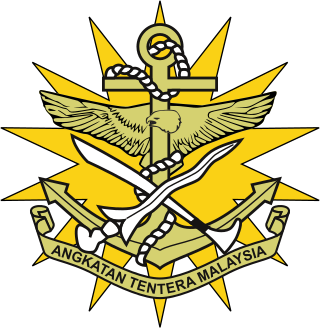
The Malaysian Armed Forces, are the armed forces of Malaysia, consists of three branches; the Malaysian Army, Royal Malaysian Navy and the Royal Malaysian Air Force. The number of MAF active personnel is 113,000 along with the reserve forces at 51,600. The Supreme Commander of the Malaysian Armed Forces is the Yang di-Pertuan Agong; the King of Malaysia.

A coast guard or coastguard is a maritime security organization of a particular country. The term embraces wide range of responsibilities in different countries, from being a heavily armed military force with customs and security duties to being a volunteer organization tasked with search and rescue without law enforcement authority. In most countries, a typical coast guard's functions are distinct from those of the navy and the transit police, while in certain countries has similarities to both.

The Royal Malaysian Navy is the naval arm of the Malaysian Armed Forces. RMN is the main agency responsible for the country's maritime surveillance and defense operations. RMN's area of operation consists of 603,210 square kilometers covering the country's coastal areas and Exclusive Economic Zones (EEZ). RMN also bears the responsibility of controlling the country's main Sea Lines of Communications (SLOC) such as the Straits of Malacca and the Straits of Singapore and also monitors national interests in areas with overlapping claims such as in Spratly.

The Police Coast Guard (PCG) is a division of the Singapore Police Force that combines the functions of marine police and coast guard in Singapore. Its duties include the law enforcement and search and rescue operations in collaboration with the Maritime and Port Authority of Singapore and the Immigration and Checkpoints Authority. It is headquartered at Brani Regional Base on Pulau Brani.

Piracy in the Strait of Malacca has long been a threat to ship owners and the mariners who ply the 900 km-long sea lane. In recent years, coordinated patrols by Indonesia, Malaysia, Thailand, and Singapore along with increased security on vessels have sparked a sharp downturn in piracy.

The Royal Malaysia Police, is a (primarily) uniformed national and federal police force in Malaysia. The force is a centralised organisation. Its headquarters are located at Bukit Aman, Kuala Lumpur. The police force is led by an Inspector-General of Police (IGP) who, as of 4 May 2021, is Acryl Sani Abdullah Sani.
The Royal Malaysia Police Air Operation Force is a special unit of Royal Malaysia Police (RMP). They look after national security by surveillance and patrol from the air and help other national security agencies.

Malaysia–Singapore relations, also known as Malaysian–Singaporean relations, refers to the bilateral relations between Malaysia and the Republic of Singapore, after the expulsion of Singapore from Malaysia in 1965. Singapore has a high commission in Kuala Lumpur and a consulate general in Johor Bahru, while Malaysia has a high commission in Singapore. Both countries are full members of the Commonwealth of Nations and ASEAN.

The General Operations Force is the light infantry arm of the Royal Malaysia Police. The General Operations Force was established in 1948 during the Malayan Emergency by the British Administration when Malaya was a colony. The police service was mobilised to the field role, primarily to engaging Communist guerrillas during the emerging Insurgency. When Malaysia was formed in 1963, this law enforcement unit was then known as the Police Field Force. The title was adopted when it dropped the previous handle widely referred to as the Jungle Squad.

The Marine Assault Team (MAST), formally known as the UNGERIN is a maritime counter terrorism and tactical unit of the Royal Malaysia Police's Marine Operations Force. Fully operational in 2007, the UNGERIN conducts anti-piracy and counter-terrorism operations in the coastal waters surrounding Malaysia and assists the marine police to respond swiftly.

The Special Task and Rescue or STAR is the maritime tactical unit of the Malaysian Maritime Enforcement Agency established to protect the local maritime assets of Malaysia.

The Ministry of Transport, abbreviated MOT, is a ministry of the Government of Malaysia that is responsible for transport: road transport, civil aviation, marine, road safety, port authority, railway assets, maritime, air accident investigation, logistic, maritime safety, shipping, rail transport, airport, airline.
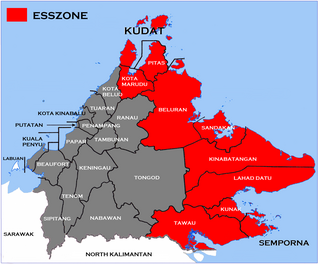
The Eastern Sabah Security Zone (ESSZONE) is a security zone in the Malaysian state of Sabah that was launched by Malaysian Prime Minister Najib Razak on 25 March 2013 following persistent attacks by pirates and militants from the southern Philippines that occurred in the eastern part of Sabah especially after the 2013 Lahad Datu standoff. It includes the districts of Kudat, Kota Marudu, Pitas, Beluran, Sandakan, Kinabatangan, Lahad Datu, Kunak, Semporna and Tawau.
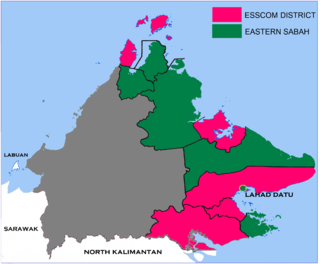
The Eastern Sabah Security Command(ESSCOM) is a Malaysian security area that covers 1,400 km of the east coast of Sabah from Kudat to Tawau. It was established by Malaysian Prime Minister Dato' Seri Najib bin Abdul Razak and announced on 7 March 2013 by Musa Aman, the Sabah State Chief Minister. Its purpose is to strengthen maritime security in the eastern part of Sabah following the persistent attacks by pirates and militants in the southern Philippines especially after the 2013 Lahad Datu standoff, while at the same time ensuring that trade and business activity are not affected. The ESSCOM headquarters and main bases is at Lahad Datu.
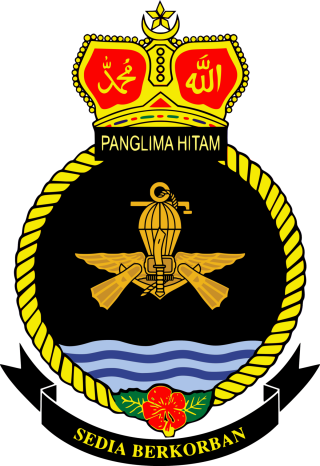
The Pasukan Khas Laut, commonly abbreviated to PASKAL, is the principal special operations force of the Royal Malaysian Navy.

The Bunga Mas Lima class is a class of auxiliary ships in service with the Royal Malaysian Navy (RMN). The class comprises two ships: KA Bunga Mas Lima and KA Bunga Mas Enam. Each ship has a length of 132 metres and displaces about 9,000 tonnes.
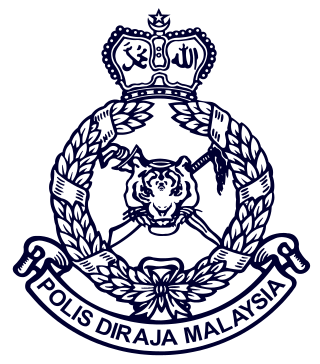
The Inspector-General of Police, also known as the Chief of Police, is the highest-ranking police officer of the Royal Malaysian Police. Assisted by the Deputy Inspector-General of Police, he reports to the Minister of Home Affairs. The IGP is based at Bukit Aman, Kuala Lumpur which is the Headquarters of the RMP.
The Special Forces and Elite Forces include both a specially and higher trained unit and a small percentage of personnel from a specific Malaysian military branch, law enforcement or government agency. In Malaysia, the term 'Special Forces' is widely used by uniformed services for special forces, special operations forces and 'special' trained units while 'Elite Forces' for units that more trained and capable combat. Regular personnel must undertake specialized and higher training to be able to join the units of the 'Special and Elite Forces'. These 'Special and Elite Forces' are denoted by different beret colours, shoulder tabs, unit patches, skill badges and uniforms.





















